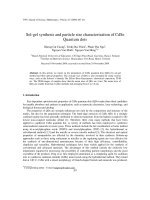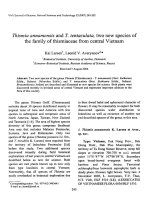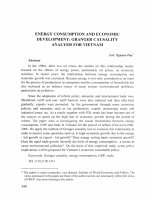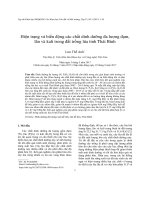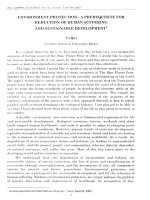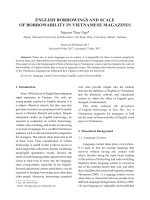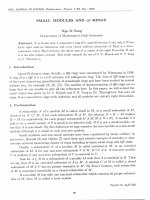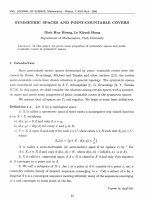DSpace at VNU: Sol-gel synthesis and particle size characterization of CdSe Quantum dots
Bạn đang xem bản rút gọn của tài liệu. Xem và tải ngay bản đầy đủ của tài liệu tại đây (866.47 KB, 5 trang )
V N U Jo u rn a l o f Science, M athem atics - Physics 25 (2009) 207- 211
S ol-gel synthesis and particle size characterization o f CdSe
Quantum dots
K h o n g C a t C u o n g ', T r in h D u e T h i e n ', P h a m T h u N g a ' ,
N g u y e n V a n M i n h ', N g u y e n V a n H u n g *
^ỉỉa n o i N ational U niversity'of Education, lĩó X u a n Thuy Road, C auG iay, Hanoi, Vietnam
hìstituỉe o f Síateriaỉs Science. Hoang Quoc Viet Road, Hanoi, Vietnam
Received 9 N o v e m b e r 2009; rcceivcd in revised form 24 N o v e m b e r 2009
A b s t r a c t . In this article, we report on the preparation o f C dSe q uan tum dots (Q D s) by sol-gel
m ethod and their optical properties. The average size o f Q D s is also estim ated by using various
ways, such as the S c h e r e r ’s formula. T he E ff ro s - B r u s - K a y a n u m a 's theoretical expression, TEM
ctc. I hc TILM images o f sam ples show that the m ean sizes o f Q D s are 4 nm. The m ean sizes o f
QD s arc sm aller than that o f other m ethods and arranging from 2 to 3.6 nm.
1.
I n tr o d u c t io n
Size-dcpendcnt optoelectronic properties o f CdSe quantum dots (Q D s) make them ideal candidates
for tunable absorbers and em itters in application, such as nanoscale electronics, laser technology, and
biological iluorcsccnt labeling.
I'hc properties o f Q D s are strongly influenced not only by the com position and structure o f the
b u t ali>u b y Ihc p i c p a i a l i u i i Ic c lim q u c . Ilic b a n d - c d g c ciiiibbiOĩi OÍ C d b c Ụ D s in a s tro n g ly
confincd regime has been generally altributed lo electron transitions from the highest occupied to the
lowest no n-occupied m olecular orbital [1]. Therefore, there exist m any m ethods that have been
applied to synthesize C dS e quantum dot. A variety o f m ethods has been em ployed to synthesize
sem iconductor nanorods in rcccnl years. 'Fhcse methods include the hot coordination solvents method
using tri-//-octylphosphinc oxide (TO P O ) and trioctylphosphinc (TO P ) [2], ihc hydrothermal or
solvothcrmal m ethod [2,3] and the micelle or reverse micclle m ethod [3]. T h e electrical and optical
properties o f nanoparticlcs arc affcctcd by the chcm istry involved in their synthesis. Bottom-up
approaches such as those using surfactants or miccllcs as the regulating agents are very cffcctive for
the synthesis o f onc-dim cnsional nanostructure because o f their high efficiency, controllability,
simplicily and versatility. H ydrotherm al techniques have been w idely applied for the synthesis o f
conventional and advanced materials. The advantages o f this m ethod include the relatively low
temperature required for processing, the possibility o f controlling particle m orphology and the good
crystalline o f the products. Peng et al. first em ployed am m onium as a com pleting agent for cadm ium
ions to synthesize cad m ium selenide (CdSe) nanocrystals using the hy droth en nal method. T hey found
that at 140 °c, CdS c with a m ixed m orphology o f branch-shaped fractals and nanorods was produced,
Corresponding author. E-mail:
207
208
K .c . C uong et a l / VN U Jo u rn a l o f Science. M athem atics - P hysics 25 (2009) 20 7 -2 Ị Ị
and at 180
the products were mainly CdSc nanorods [4]. Chen ct al. used a cationic su rfacta n t
cetyltrimethyl am m onium brom ide (C T A B ) via a hydrothermal m ethod at 180 ° c to synthesize CdSe
nanorods. T hey found that the concentration o f C T A B is a key param eter in the control o f nanoparticlc
m orphology [5]. H ow ever, to investigate the size effect w e need the sam ple with hom ogeneous
distribution in particle size. Besides that, the hydrothennal method requires the long lime reaction and
its distribution in particle size is in the broadening range.
In this article, w e report on the preparation o f CdSe quantum dots (Q D s) by sol-gel method and
investigate their optical properties. This is a new route to get C dS e Q D s and also very economic. We
also estimate the average size o f Q D s by using various ways, such as ửie S c h c r c r 's formula, The
E f f ro s -B ru s-K a y a n u m a ’s theoretical experssion, T E M etc.
2. E xperim ent
The m ethod used to prepare Q D s CdSe w as presented in previous paper [ 6 ]. The crystalline
processes happened from 1 to 15 minutes, and Q D s CdSe w ere dispersed in toluen solvent.
Pow der X-ray diffraction (X R D ) patterns were recorded using a D 5005 (Siemens) X-ray
diffractometer using CuA^a radiation {X = 0.15406 nm). Transm ission electron m icroscopy (TEM ) was
earned out using a m icroscope. U ltraviolet-visible (U V -v is) absorption spcctra o f the nanoparticlcs
were recorded by using a Jasco V 670 spectrophotometer.
3. Result and discussion
To calculate the particle size o f Q D s we use some following models:
+ Using absorption spectra to estimate the m ean sizes o f QDs:
The E ffros, B ru s and K a y a n u m a ’s theoretical expression shows the relation between mean si/i’
and speciiic param eters of Q D s [7J;
E . W = E , + ji' r ;
- 0 ,2 4 8 R *
(1)
a ;
w here Eg(a) is the e ffectiv e b an d gap o f Q D s w ith radius o f a, the band gap Eg, B o h r cxciton radius
3b and B ohr exciton energy R* are the specific param eters o f bulk material. F ro m absorption
spectra, w e can d e te rm in e the Eg(a) o f Q D s, h en ce can estim ate the m e a n size o f Q D s.
From this formula, the standard curve and m easured absorption spectra, w e can estim ate the mean
size o f QDs.
Based on the analysis it has been expressed the experimental formula to estim ate the mean sizes o f
Q D s C dSe as:
Z) = 1,6122 X 10"’
- 2 , 6 5 7 5 X 10^ Ắ' +1,6242 X 1 0 - 'A ' - 0 ,4 2 7 7 ^ + 41,57
(2)
where, D (nm ) is the size o f a given nanocrystal sample, and ^ n m ) is the w avelength o f the first
excitonic absorption p eak o f the corresponding sample.
+ The second one, we estimate the m ean size o f Q D s by the S c h e re r’s formula [ 8 ]:
r = -...........;;
D cosO
(3)
K
c. CỉíOtìịĩ eỉ a l / VNU Jo u rn a l o f Science, M athenuitics - P hysics 25 (2009) 207-2 Ỉ I
209
where, i:) (rad) is the half width at halt maximum
o f the XIU) peak; X- the X-ray difTraction
o
wavelength (with radiation C uK a: À = 1,5406 A );
0 : Ih c d i i i 'r a c l i o n a l a n g l e a n d k - c o n s ta n t (k
- 0,9).
The strucUire and m orphologies o f the
CdSe nanoparticlcs were characterized using
' V “ -t.
transm ission
electron
microscopy.
The
niorphoiogics o f the CciSc nanoparliclcs were
mainly alTcclcd by ihc C d :S c ratio, the rcaclion
temperature and lime. F’roiii VEM im age on fig.
1 , \vc can sec C d S e Q D s are disp ersed in
e 3 4 '4
8 8 . 8 KU^ X 180K
S0na
loluen solvent and have the sphcrical shapes
wilh the mean d ia m e te r o f about 4 nni.
Fig. 1. TEM image ofCdSe QDs.
A typical X R I) pattern from the prepared
CdSe nanoparticlcs and the positions o f the Xray peaks tor CdSe \ cc are shown in rig. 2 . A ll the diffraction peaks from the CdSe nanoparticles are
consistent witli the wurtzilc structure o f C dSe with m easured lattice constants o f a = 6.1 Ả (this can be
compared to the lattice constants o f a = 6,077 A from JC P D S file No. 19-0191). The sharp diffraction
peaks a h o indicate lliat the products are highly crystalline. X R D analysis revealed no impurities such
as Se and ScO^ in the sample.
As cxpcclcd, the widtli o f the difTraction peaks is considerably broadened and can be determined
easily because tlic s i/e eifcct is exliibited vcr)' d e a r. By using the Scherrer formula, u e can calculate
ihe mean sizes o f llie C J S e Q D s from the peak width at half-m axim um . Parliclc sizes obtained from
the width ol'th e ( 1 1 1 ) diiiraction are depleted in the tabic 1 .
Tahlo 1 Panicle si/e o f ‘inniple*^ with reaction time s atui li) min
Samples
5 Iiiinutos
10 minutes
D (radian)
20
25,381
25,402
These results .'ihow that llie
panicle si/cs arc about 2 nm.
When
tlic
cr\slallin c
time
increased iVoiri 5 to 10 minutes, the
peaks bccome broadening but not
ver\ considerably.
The mean s i/c s o f samples
obta ned from X R I) patterns arc
smaller than those o f these samples
obla ncd iVom I HM image. In this
m etlod. we did not elim inate ihc
sysUni standard error. In addition,
in tiis X RI) niclliod, the mean
sizes are obtained from all the
structural
layers
of
samples
0,0697
0,06806
d (nm)
cosO
0,97555
0,97553
2,039
2,088
C d S e F F C stru ctu re
(220)
A,
’Mv
10
20
30
(311)
10 mi n
5 min
V'
40
50
60
70
2 Theta (degree)
F-'ig. 2. XRD patterns ofQ D s CdSe with crystalline times o f 5 and 10
minutes.
210
K ( ' ('ĩỉonii eí aỉ.
\'N U Jo u rn a l o f Science, h iathem atics - P hysics 25 (2009) 2 ( r - 2 ỉ ỉ
In i h c o t l i c r iii c t liio d s ,
there are some other objccts which arc involved in the shell o f C dS e cores so it may be larger.
Fig. 3 shows absorption spectra, o f the
prepared C dSc QDs. it can be seen from F'ig. 3
that with increasing grow ing lime, the redshift o f
the spectra can be clearly observed and optical
absorption in the visible region due to CdSe Q Ds
is demonstrated. The average diameters o f the
C dSe Q D s for each growth time interval is
estimated using the cffcctivc mass approximation
giving diameters ranging from 2 . 2 nm to 2 . 6 nm.
These values are com parable to those obtained by
TEM and by the w av e le n g th o f the first excitonic
a bsorption peak (T ab le 2).
The deviation o f the peaks in absorption
spectra is about 50 nm, w hich may be due lo the
difference o f surface states o f these QDs. It is also
thought that the strong intensity from the CdSe
Q D s can be attributed to their high crystallinity
W a v e l e n g t h (n m )
[9], which is in good agreem ent with the X RD
Fig. 3. U V -v is absorption spectra o f CdSe Q D s with
patterns discussed earlier and the presence o f good
various crystalline times.
surface states on the QDs.
i n v o l v e d d i f f r a c t i o n p r o c c s s , s o tliC r e s u l t s a r c tlie d i a m e t e r s o f c r y s t a l COICS.
Table 2. The parameters o f the C dSe Q D s vs. grow ing lime
Ratio
Cd:Se
1:8
(2 6 0 T )
Nam e
CdSe
CdSe
CdSe
CdSe
crystalline
The m ean diam eter o f T he mean diam eter o f
The wavelength o f the
time (m inute) first absorption excitonic C dSe Q D s using formula
C dSe Q D s using
peak (nm)
(l)(n m )
formula (2) (nm )
1
520
2.2
2.6
5
557
2.5
3.2
10
56!
2.5
3.3
15
574
2.6
3.6
Sum m ary
In summary, Q D s o f C d S e with a diam eter o f 2.2 - 2.6 nm have been successfully synthesized
through a novel m ethod at a relative low temperature. The m orphologies o f the prepared nanoparticlcs
can be controlled by the reaction time, the am ount o f Cd:Se ratio and the reaction temperature.
A ck n ow led gem en ts. The authors express the sincere thanks to the N A F O S T E D under Grant number
o f 103.03.93.09 and Ministerial-level project o f M O E T for the financial support.
K .c . C uong ct a I. / VNU J o u rn a l o f Science, M athem atics - P hysics 25 (2009) 2 0 7 -2 ! I
2 11
R eferences
[1]
lỉkim ov .7. L iw un 70 (1996) h P.D. Pcrsans, Au I'u. Y J . \Vu, M. l.cvis. J, D pi Soc Am 6 ( 1 9 8 9 ) 818-; V. JungnickcK
i'. IIcnncbcrgcr, J ỉ.unun ^0 (1996) 238; T. Aral, K. Matsuishi, J Luntifi 70 (1*>96) 281; M, Kuno, J.K. Lee, B .o .
Dabbousi, F . v Mikulcs, M.G. U a w c n d i . a c/ie m rh ys. 1 0 6 ( 1 9 9 7 ) 9 8 6 9 .
[2]
X.G. Pcnii, L. Manna, \v.[). Yanti, J, Wickham, \~. Schcr, A. Kadavanii'h, A-P. Alivisatos, S a iu re ‘iOA (2000) 59.
13]
L.r. Xi. YM . I,ani, J ('oỉỉouỉ InicrfiUV Set 316 {2007) 771; M MaiilarJ, s. Giorgio, M.p. Pilcni, Adv. Mater. 14
[4]
Q Peng. V J . Dong, / X. Deng, Y.D. Li, ỉnorịĩ C h a n 41 (20U2) 5249.
[5]
M ,n . Chen, L. G ao, J. A m Ceram . Soc. 88 (2005) 1643.
[6|
K hong Cat Cuoni*. T n n h Due Thicn, Pham Van Hai, Nguyen Phi Hung, Bui Thi P huong 'Ilianh, N guyen \^an Hung,
( 2 0 0 2 )1 0 8 4 .
Pham Thu Nga, V'u [)uc Chinh, Vu 'Ihi Hontĩ íỉanh, Synthesis C d S c quantunidols and determine its SI/C from optical
spcclra, A d va n ces in O p tics P hotofitcs Spectro sco p y ổí A p p iica tto n s V (2008) 517.
[7]
S. V.Gaponenko, Optical Ề^ropcrties o f Semiconductor Nanocrysíaỉs, Cambridge University Press, 1998.
[8]
Lc Cong D uong, The sírư cíu ra ỉ a nalyze by A>m', Publishing H ouse for Science and T echnology ỉlanoi, 1984.
[9] R. Vcnugopal, p'l. Lin, c . c Liu, Y.T. C h e n , / Am. Chan. Soc 127 (2005) 1 1262-
